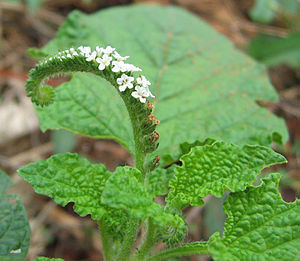Note: This is a project under development. The articles on this wiki are just being initiated and broadly incomplete. You can Help creating new pages.
Heliotropium indicum - Bhurundi
Bhurundi is an erect, usually much-branched, annual to perennial plant. It can grows up to 1.5 metres tall. The stems are usually woody at the base. The plant is often harvested from the wild and used locally for its medicinal virtues.
Uses
Parts Used
Chemical Composition
This plant contains many important Phytochemicals, Including Pyrrolizidine Alkaloids, Indicine, Echinitine, Supinine, Heleurine, Heliotrine, Lasiocarpine, Acetyl indicine, Indicinine, Indicine N-oxide, Cynoglossine, Europine N-oxide, Heleurine N-oxide, Heliotridine N-oxide, Heliotrine N-oxide.[3]
Common names
| Language | Common name |
|---|---|
| Kannada | Bhoorundi, Celubaladagidha, Chaelu baalada gida, Chaelu mani, Chaelubaala |
| Hindi | Hatta-juri, Hatisura |
| Malayalam | Tekkata, Tekkita, Teliyenni, Telkata |
| Tamil | Aanaikundrimani, Anai Kundumani |
| Telugu | Kodikki, Naga danti |
| Marathi | NA |
| Gujarathi | NA |
| Punjabi | NA |
| Kashmiri | NA |
| Sanskrit | Bhurundi, Duralabha, Hastishundi, Srihastini, Suryavarta, Vrscikali, Nagadanti |
| English | Indian heliotrope |
Properties
Reference: Dravya - Substance, Rasa - Taste, Guna - Qualities, Veerya - Potency, Vipaka - Post-digesion effect, Karma - Pharmacological activity, Prabhava - Therepeutics.
Dravya
Rasa
Tikta (Bitter), kashaya (Astringent)
Guna
Laghu (Light), Snigdha (Oily)
Veerya
Ushna (Hot)
Vipaka
Karma
Pitta, Vata
Prabhava
Habit
Identification
Leaf
| Kind | Shape | Feature |
|---|---|---|
| Simple | Opposite | Leaves simple, opposite, 11 x 6 cm, sub-deltoid or broadly ovate, apex acute,base turncate, margin undulate, chartaceous; petiole 3-6 cm long |
Flower
| Type | Size | Color and composition | Stamen | More information |
|---|---|---|---|---|
| Bisexual | Curved spikes | Violet or pink | 5 | Flowers sessile, in terminal or leaf-opposed curved, to 20 cm long spikes. Flowering from April to October |
Fruit
| Type | Size | Mass | Appearance | Seeds | More information |
|---|---|---|---|---|---|
| Nutlet | 2 - 3 mm | Nutlets connate in pairs, separating later, ribbed | Fruiting from April to October |
Other features
List of Ayurvedic medicine in which the herb is used
Where to get the saplings
Mode of Propagation
How to plant/cultivate
Originally from S. America, the plant has spread and become naturalized through much of the tropics and subtropics. Plants can flower all year round[6]
Commonly seen growing in areas
Photo Gallery
References
- ↑ Uses
- ↑ ”Karnataka Medicinal Plants Volume-3” by Dr.M. R. Gurudeva, Page No.438, Published by Divyachandra Prakashana, #6/7, Kaalika Soudha, Balepete cross, Bengaluru
- ↑ Journal Paper from National Library of Medicine - Heliotropium indicum L.: From Farm to a Source of Bioactive Compounds with Therapeutic Activity
- ↑ Vernacular names
- ↑ Botonic description
- ↑ Tropical the Ferns Information about Cultivation
External Links
- Ayurvedic Herbs known to be helpful to treat Wound healing
- Ayurvedic Herbs known to be helpful to treat Skin diseases
- Ayurvedic Herbs known to be helpful to treat Insect bites
- Ayurvedic Herbs known to be helpful to treat Fever
- Ayurvedic Herbs known to be helpful to treat Eye pain
- Herbs with Leaf used in medicine
- Herbs with Root used in medicine
- Herbs with Seed used in medicine
- Herbs with common name in Kannada
- Herbs with common name in Hindi
- Herbs with common name in Malayalam
- Herbs with common name in Tamil
- Herbs with common name in Telugu
- Herbs with common name in Sanskrit
- Herbs with common name in English
- Habit - Herb
- Index of Plants which can be propagated by Seeds
- Index of Plants which can be propagated by Cuttings
- Herbs that are commonly seen in the region of Tropical area
- Herbs that are commonly seen in the region of Sub tropical area
- Herbs
- Boraginaceae






